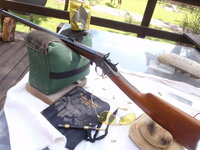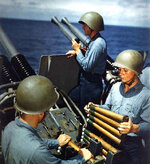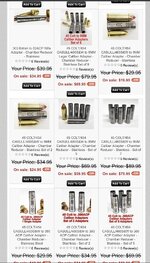Navigation
Install the NWFA app
How to install the app on iOS
Follow along with the video below to see how to install our site as a web app on your home screen.
Note: This feature may not be available in some browsers.
More Options
You are using an outdated browser
The browser you are using is likely incompatible with our website. We recommend upgrading your current browser or installing an alternative.
JavaScript is disabled
Our website requires JavaScript to function properly. For a better experience, please enable JavaScript in your browser settings before proceeding.
-
Join the #1 community for gun owners of the Northwest
We believe the 2nd Amendment is best defended through grass-roots organization, education, and advocacy centered around individual gun owners. It is our mission to encourage, organize, and support these efforts throughout Oregon, Washington, Idaho, Montana, and Wyoming.Free Membership Benefits
- Fewer banner ads
- Buy, sell, and trade in our classified section
- Discuss firearms and all aspects of firearm ownership
- Join others in organizing against anti-gun legislation
- Find nearby gun shops, ranges, training, and other resources
- Discover free outdoor shooting areas
- Stay up to date on firearm-related events
- Share photos and video with other members
- ...and much more!
Poll: Would you own/shoot a rechambered firearm?
- Thread Starter CountryGent
- Start date
I've got a Ruger Single Six. Every so often I rechamber it myself. I just pull this little pin/doohickey thingy out and put the .22 magnum cylinder in. It's really not as tough as it sounds, but then maybe I'm just special and perhaps overqualified. I'm also pretty awesome at re-chambering it back to the original .22 long rifle configuration, but sometimes have trouble remembering which cylinder is which. I'm old doncha know? 



Bronze Lifetime
- Messages
- 6,435
- Reactions
- 12,506
I have an Enfield that's chambered in 45ACP and uses 1911 mags. So I guess the first option.
- Messages
- 1,005
- Reactions
- 1,460
S&W Victory.Oh, what revolver?
- Messages
- 2,927
- Reactions
- 5,519
the Navy converted thousands of m1 Garands from 30-06 to .308Based a couple recent conversations with a family member and an acquaintance: would you own and/or shoot a firearm that had been rechambered from its original, factory chambering? Why or why not? If you should have such a piece in your collection at the present, what would it be?
Thanks for sharing.
never heard of a problem with one
based on this I converted my Garand to .308 back in '91
don't even use a .308 block in it, just load in the original clips
Gold Supporter
Silver Supporter
Bronze Supporter
- Messages
- 5,622
- Reactions
- 8,835
I have seen some rechamber / rebarreled jobs that have scared me. Take a small ring mauser and chamber it in 308 win. H3ll is not cold enough by a long shot to make that one safe in my opinion.
- Messages
- 2,808
- Reactions
- 3,965
Yes, I have with no issues. Using chamber inserts to allow 7.62x51 in .30-06 Garand and in .30-06 Springfield to 7.62x51. .38 spec in .357, and 9mmP in 9mm Largo ( not very successful, but no dangerous over-pressure signs or split cases/flattened primers)... Oh and .22LR in .22mag cylinder. Split the LR cases, not all that accurate either. Young dumb and too cash-strapped to afford the magnums at the time.Based a couple recent conversations with a family member and an acquaintance: would you own and/or shoot a firearm that had been rechambered from its original, factory chambering? Why or why not? If you should have such a piece in your collection at the present, what would it be?
Thanks for sharing.
Last Edited:
Gold Supporter
- Messages
- 287
- Reactions
- 343
I have a 1909 Argentine Mauser rechambered to 3006. My Dad purchased it, so chambered, from GI Joes in about 67'-68' for $35. 2 model 93 Mausers were purchased at the same time, both in their (original?) 7mm chambering, for $15 ea. Those 2 immediately exhibited signs of excessive head space and were discarded. The Argentine, while providing mediocre accuracy, has never given any cause for concern. The accuracy issue is possibly due to the 7.65 bore of the original chambering.
Staff Member
Gold Supporter
Bronze Lifetime
- Messages
- 23,296
- Reactions
- 111,637
Sure if....
The firearm was a quality build in the first place...and gunsmithing / custom work was also of quality....
And...if the rechambering was of a cartridge suited to firearm.
A lot of If there....
But then back in the day...there was also a lot of quality custom work as well.
Andy
The firearm was a quality build in the first place...and gunsmithing / custom work was also of quality....
And...if the rechambering was of a cartridge suited to firearm.
A lot of If there....
But then back in the day...there was also a lot of quality custom work as well.
Andy
- Messages
- 532
- Reactions
- 576
He didn't say just rifles so yes. Thompson Contender, 40 S&W to .357 sig. 45 ACP to 10mm. Do I keep going? What about 22lr conversions?
- Messages
- 532
- Reactions
- 576
I have a M1903 A3 rechambered in 30-338 Win Mag shoots great.I have a Smith-Corona M1903 A3 that was rechambered to 308 NORMA Mag in the early 60's. Don't how many Deer and Elk or rounds shot through it. But it's been a few. So yes I would shoot a gun that's been rechambered.
- Messages
- 33
- Reactions
- 77
Yes, I would and have fired rechambered firearms. I have purchased many guns to rechamber into what I want, and will continue to do it.
Gold Supporter
Silver Supporter
Bronze Supporter
- Messages
- 5,622
- Reactions
- 8,835
I have had mausers rechambered to 8mm-06 and 8mm-06AI that worked quite well. I would do it again.
Like many others have said, my answer would be qualified by variables. One notable and pathetic old rifle that was given to me was a Ludwig Loewe Model 1893 Turdish Mauser. I went out and bought a set of 7.65x53 Mauser dies, some .311 bullets and some new brass. I combined these ingredients, and the first round I test seated in the chamber kind of disappeared. I didn't have any of that chamber molding stuff that Brownell's sells, so I substituted candle wax. The result showed that someone had crudely bored the rifle out to take .30-06 ammo. If you looked at the profile of the barrel where it screws into the receiver, it was obvious that the .30-06 case incurred overly into the tapering area of the rifle barrel. I was never adventuresome enough to fire a full load .30-06 round in it, but I did load up some cat sneeze loads that were puny enough so as to not blow me up.
I had one of those 5 in. bbl. Smith & Wesson .38/200's that were made for the British Empire in WW2 that said, "Rebored in Australia" on it. The chambers had been opened up to take .38 Special ammo. It never gave me any problems but it was Hell on .38 Spec. brass which would expand excessively in the case head area, which is larger on the .38/200 case than the Special.
I've used some of the USN inserts to convert .30-06 to 7.62mm NATO. I also own a number of those chamber sleeves that convert X cartridge to take a subcaliber round.
The thing about modifications, yes, they may work fine (so far) in one's experience. But there is always the little Demon that assigns how many shots are allowed in badly done work until it choose to come apart.
I had one of those 5 in. bbl. Smith & Wesson .38/200's that were made for the British Empire in WW2 that said, "Rebored in Australia" on it. The chambers had been opened up to take .38 Special ammo. It never gave me any problems but it was Hell on .38 Spec. brass which would expand excessively in the case head area, which is larger on the .38/200 case than the Special.
I've used some of the USN inserts to convert .30-06 to 7.62mm NATO. I also own a number of those chamber sleeves that convert X cartridge to take a subcaliber round.
The thing about modifications, yes, they may work fine (so far) in one's experience. But there is always the little Demon that assigns how many shots are allowed in badly done work until it choose to come apart.
Silver Supporter
Bronze Supporter
- Messages
- 4,210
- Reactions
- 6,918
No Sweat.
Current faves: Ruger tang safety M77 .257 Roberts Improved.
Siamese Mauser .45-70
Rechambering is no different than any other job: good 'Smith, good work.
Nervous with a newly acquired rechambered gun with no red flags? Strap it to a tire and run a box through it.
Current faves: Ruger tang safety M77 .257 Roberts Improved.
Siamese Mauser .45-70
Rechambering is no different than any other job: good 'Smith, good work.
Nervous with a newly acquired rechambered gun with no red flags? Strap it to a tire and run a box through it.
- Messages
- 5,791
- Reactions
- 18,182
rechambered...no problem, it's done all the time.
Resleeved/lined...that's a different story.
Resleeved/lined...that's a different story.
Silver Supporter
Bronze Supporter
- Messages
- 4,210
- Reactions
- 6,918
Once again (and just like rechambering) installing a liner is done all the time, and works very well in the calibers for which it is done, often bringing new life to guns that would languish otherwise.rechambered...no problem, it's done all the time.
Resleeved/lined...that's a different story.

Remington No. 2 Rolling Block, 22lr. When acquired, it was a keyholer. With a liner installed by a skilled 'Smith, no Hefeweisen can is safe at 50 yards. Warning: operation of this action may cause addictive dependency and frequent ammunition shortages.
- Messages
- 5,791
- Reactions
- 18,182
I know. It's done VERY wrong a lot too. Lining is much more complicated and requires very specific machinery and abilities to be done right.Once again (and just like rechambering) installing a liner is done all the time, and works very well in the calibers for which it is done, often bringing new life to guns that would languish otherwise.
View attachment 1838255
Remington No. 2 Rolling Block, 22lr. When acquired, it was a keyholer. With a liner installed by a skilled 'Smith, no Hefeweisen can is safe at 50 yards. Warning: operation of this action may cause addictive dependency and frequent ammunition shortages.
Silver Supporter
Bronze Supporter
- Messages
- 4,210
- Reactions
- 6,918
As with any other gunsmith work.I know. It's done VERY wrong a lot too. Lining is much more complicated and requires very specific machinery and abilities to be done right.
Share This Discussion
Similar threads
Upcoming Events
New Classified Ads
-
Benelli M4 OD Green w/Titanium CarrierComp Tube & Urbino Stock
- Started by clanhanson
- Replies: 0
-
XM177E2 RETRO 5.56 AR-15 CARBINE STOCK, Coated Aluminum Colt Copy.
- Started by eldbillbo
- Replies: 0
-
-
Bushnell RXS-250 Reflex Sight (RXS250) - $124.99 - free shipping over $175
- Started by Richo877
- Replies: 0
-
Federal Champion Training .22LR 36gr Lead HP 325rd Box - $17.32 - Free shipping over $175
- Started by Richo877
- Replies: 0
-
500rd can American Eagle .45 ACP 230gr - $189.99 - Free shipping
- Started by Richo877
- Replies: 0
-
100 rds 7.62x39 with 26 sks stripper clips
- Started by gunsmith007
- Replies: 0
-
Winchester Ranger T-Series .40 S&W 180gr JHP - $24.99 - Free shipping over $175
- Started by Richo877
- Replies: 0
-
CADEX DEFENCE CDX-R7 SPORTER SHORT ACTION RIFLE 6.5 PRC 24" Cadex Barrel in Hybrid TAN/BLACK
- Started by Riflecrafters
- Replies: 0
-
Support Our Community
If our Supporting Vendors don't have what you're looking for, use these links before making a purchase and we will receive a small percentage of the sale
















